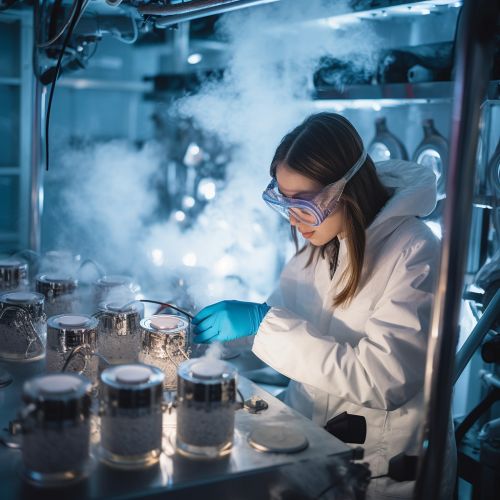Cryobiology
Introduction
Cryobiology is the branch of biology that studies the effects of low temperatures on living things within Earth's cryosphere or in science. The word derives from the Greek words "kryos" meaning cold, "bios" meaning life, and "logos" meaning science. It is essentially the study of biological material or systems at temperatures below normal. Materials or systems studied may include proteins, cells, tissues, organs, or whole organisms. Temperatures may range from moderately hypothermic conditions to deep cryogenic conditions.


History
The history of cryobiology is filled with the efforts of scientists trying to understand and exploit the effects of cold temperatures on biological systems. This field of study has its roots in the 17th century with the work of Robert Boyle, who conducted some of the first experiments on the effects of cold temperatures on animals. The field has since grown and evolved, with significant advancements in the 20th century due to the development of better equipment and techniques for cooling and storing biological samples.
Principles of Cryobiology
Cryobiology is based on several fundamental principles. The first is the principle of thermodynamics, which states that energy cannot be created or destroyed, but only changed from one form to another. This principle is crucial in understanding how biological systems respond to changes in temperature. Another important principle is the principle of cryopreservation, which involves preserving biological material by cooling it to very low temperatures. This process can preserve the structure and function of the material, allowing it to be stored for long periods of time.
Cryopreservation
Cryopreservation is a process where cells, whole tissues, or any other substances susceptible to damage caused by chemical reactivity are preserved by cooling to sub-zero temperatures. At these low temperatures, any biological activity, including the biochemical reactions that would lead to cell death, is effectively stopped. Cryopreservation methods seek to reach low temperatures without causing additional damage caused by the formation of ice during freezing.
Cryoprotectants
A cryoprotectant is a substance used to protect biological tissue from freezing damage. For example, antifreeze proteins (AFPs) are a class of polypeptides produced by certain vertebrates, plants, fungi and bacteria that permit their survival in subzero environments. AFPs bind to small ice crystals to inhibit growth and recrystallization of ice that would otherwise be fatal.
Cryonics
Cryonics is the low-temperature freezing (usually at −196°C) of a human corpse or severed head, with the hope that resurrection may be possible in the future. It is regarded with skepticism within the mainstream scientific community and has been characterized as quackery.
Cryosurgery
Cryosurgery is the application of extreme cold to destroy abnormal or diseased tissue. The surgery most often involves the use of liquid nitrogen, although carbon dioxide and argon may also be used. Cryosurgery is used to treat a variety of diseases and disorders, most especially skin conditions like warts, moles, skin tags and solar keratoses.
Cryoconservation of animal genetic resources
Cryoconservation of animal genetic resources is a strategy wherein samples of animal genetic materials are preserved cryogenically. These samples may be of semen, embryos, ova, or other genetic material. It is done to preserve the genetic diversity of a livestock species, especially those that are endangered.
